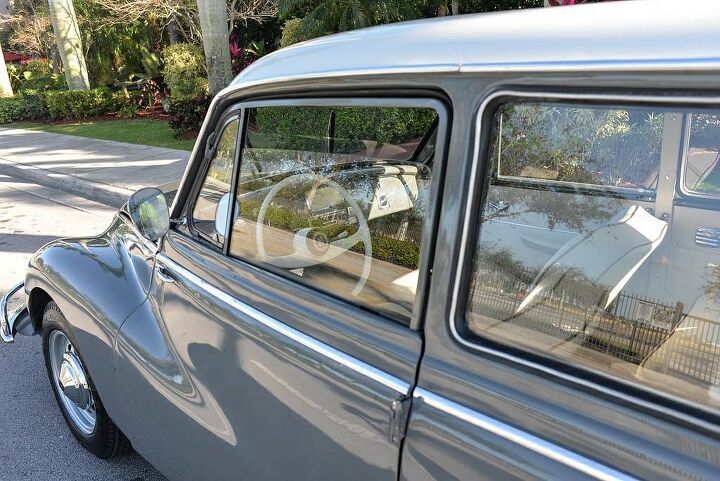Rare Rides: The DKW Wagon From 1962 - Deceptive Geography (Part II)

Last time, in Part I of this DKW wagon’s saga, we covered a condensed history of the Audi marque. From its inception as Horch, through separation, renaming, and merger into the Auto Union fold, Audi wavered along unsteadily. The company even performed a vanishing act between 1940 and 1964.
In the middle of all this history is our Rare Ride, a tidy DKW wagon from 1962. But all is not as it seems.
You see, something didn’t sit right between the historical timelines presented online and the model year of this DKW. Through a little research, I discovered the model-less wagon in the ad was actually a DKW 3=6 “Universal,” the name of the three-door wagon variant. But the front end looked a little odd, and it turned out that production of the 3=6 ended in 1959. So what gives with this 1962 model — an uninformed seller, perhaps?
Not quite. This photo betrayed one key detail of this DKW: “Vemag S.A.” Those two letters stand for “Sociedade Anónima,” a form of corporation in Brazil. Vemag produced licensed DKW vehicles with slight modifications in Brazil, between 1956 and 1967. The factory in Brazil made several models, which underneath were versions of the 3=6. Production of the F94 version of the 3=6 began in 1958, with sedan and wagon variants. Though initially the models retained their DKW nomenclature, Vemag renamed them Belcar and Vemaguet in sedan and wagon versions, respectively.
Vemag also produced a fiberglass-bodied sports car called the GT Malzoni, which would be the foundation for Brazilian sports car manufacturer Puma (still going today in South Africa).
Turns out what we actually have here is a Vemag S.A. produced DKW Vemaguet. The South American market was the very last place you could buy a new DKW, as Volkswagen wound down the Brazilian operation in 1967. And so concludes the story of DKW branded cars — a long tale for this little German/South American wagon.
It’s yours for just under $24,000.
[Images via seller]

Interested in lots of cars and their various historical contexts. Started writing articles for TTAC in late 2016, when my first posts were QOTDs. From there I started a few new series like Rare Rides, Buy/Drive/Burn, Abandoned History, and most recently Rare Rides Icons. Operating from a home base in Cincinnati, Ohio, a relative auto journalist dead zone. Many of my articles are prompted by something I'll see on social media that sparks my interest and causes me to research. Finding articles and information from the early days of the internet and beyond that covers the little details lost to time: trim packages, color and wheel choices, interior fabrics. Beyond those, I'm fascinated by automotive industry experiments, both failures and successes. Lately I've taken an interest in AI, and generating "what if" type images for car models long dead. Reincarnating a modern Toyota Paseo, Lincoln Mark IX, or Isuzu Trooper through a text prompt is fun. Fun to post them on Twitter too, and watch people overreact. To that end, the social media I use most is Twitter, @CoreyLewis86. I also contribute pieces for Forbes Wheels and Forbes Home.
More by Corey Lewis
Latest Car Reviews
Read moreLatest Product Reviews
Read moreRecent Comments
- Probert They already have hybrids, but these won't ever be them as they are built on the modular E-GMP skateboard.
- Justin You guys still looking for that sportbak? I just saw one on the Facebook marketplace in Arizona
- 28-Cars-Later I cannot remember what happens now, but there are whiteblocks in this period which develop a "tick" like sound which indicates they are toast (maybe head gasket?). Ten or so years ago I looked at an '03 or '04 S60 (I forget why) and I brought my Volvo indy along to tell me if it was worth my time - it ticked and that's when I learned this. This XC90 is probably worth about $300 as it sits, not kidding, and it will cost you conservatively $2500 for an engine swap (all the ones I see on car-part.com have north of 130K miles starting at $1,100 and that's not including freight to a shop, shop labor, other internals to do such as timing belt while engine out etc).
- 28-Cars-Later Ford reported it lost $132,000 for each of its 10,000 electric vehicles sold in the first quarter of 2024, according to CNN. The sales were down 20 percent from the first quarter of 2023 and would “drag down earnings for the company overall.”The losses include “hundreds of millions being spent on research and development of the next generation of EVs for Ford. Those investments are years away from paying off.” [if they ever are recouped] Ford is the only major carmaker breaking out EV numbers by themselves. But other marques likely suffer similar losses. https://www.zerohedge.com/political/fords-120000-loss-vehicle-shows-california-ev-goals-are-impossible Given these facts, how did Tesla ever produce anything in volume let alone profit?
- AZFelix Let's forego all of this dilly-dallying with autonomous cars and cut right to the chase and the only real solution.






































Comments
Join the conversation
In the late 50's and early 60's DKW cars were often seen in and around London in addition the very stylish DKW two stroke motorcycles were popular. Compared to the pitiful James and BSA singles the DKW's were sleek, with much of the mechanical bits hidden beneath cowlings with leading link front suspension and most of the brightwork in polished aluminum and deeply valanced mudguards.
It wasn't uncommon back then for cars to be built under license in South America, with cars being facelifted, yet still recognizable. One example would be the IKA-Renault Torino, a '64-'65 Rambler American, refreshed by Pininfarina, built in Argentina by a subsidiary of Kaiser Motors, and later taken over by Renault. Whoa, now I've got a headache. https://en.wikipedia.org/wiki/IKA-Renault_Torino